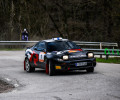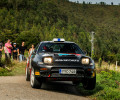EHSRC: Introducing the Las Vegas Ypres Historic Rally
The 27th edition of the Ypres Historic Rally is round 4 of the 2019 FIA European Historic Sporting Rally Championship. The rally HQ and service park is based in the Belgian town of Ypres, close to the battlefields of World War 1.

The event will begin on Friday in the afternoon 28th June 2019 at the Menin Gate in Ypres and will continue with three special stages in the evening. After the overnight halt another eleven special stages will be held on Saturday 29th June, making it fourteen stages in total over the two days. The Podium Ceremony and prize-giving will be held in the Market Place in Ypres on Saturday evening.
The Las Vegas Ypres Historic Rally is a compact asphalt rally with plenty of access for spectators on the stages. The rally is run on narrow, twisty farm roads and demand full concentration from the crew where mistakes can be costly in terms of time and damage to the cars. The roads are so typical that local drivers are always difficult to beat in Ypres, be it in the modern or in the historic rally.
On Friday evening there are three special stages totalling 32.05km. SS101 is Kemmelberg, the 13.09km stage beginning at 17h11. This will be followed by two runs on the 9.48km Zonnebeke stage, with the first car due at 19h11 on SS102, followed by the second run (SS103) at 20h00 on the same course.
On Saturday 29th June the first of the eleven stages is Langemark with a distance of 8.65km, with the first car due at 10h25. This will be followed by Reninge (11.82km), Vieteren (10.87km) and Watou (14.02km).
After a service stop SS108 at Dikkebus (12.53) will start at 13h38, followed Wetouter-Boeschepe (20.33km) and Zillebeke (14.37km).
Another Service stop will be followed by the final four stages, which are a rerun of the first four held on Saturday morning. The first car due at Langemark (8.65km) at 16h29 followed by Reninge 2, Vieteren 2 and concluding with Watou 2 (SS114) with the first car due at 17h42. The final stage will be followed by the prize giving ceremony in Ypres.
Facts and Figures
Number of special stages - 14 (9 different)
Number of legs - 2
Total distance of the course including the special stages - 387.97 km
Total distance of the special stages - 170.16 km
Friday 28 June – Distance of Special Stages - 32.05km
Saturday 29 June – Distance of Special Stages - 137.95km
Interval between cars - 1 minute
For more information on the Las Vegas Ypres Historic Rally CLICK HERE
A Look Back at 2018
Last year the top finisher in the FIA European Historic Sporting Rally Championship was the Category 3 Porsche 911 of eventual champions Karl Wagner and Gerda Zauner, the Austrians finishing 32 seconds ahead of their nearest rivals. Maximum points in Category 4 went to Tim and Steve Jones in the Ford Sierra Cosworth.
The top FIA entered car in Category 2 was the Porsche 911 of Belgian pairing Carlo Mylle and Steven Vyncke, which finished behind the Porsche 911 of Sweden’s Anders and Ingrid Johnsen. Antonio Parisi and Giuseppe D’Angelo were the victors in Category 1, the Italians taking another haul of championship points on their way to the 2018 title.
The Historic Town of Ypres
Ypres is a Belgian municipality in the province of West Flanders. Though the Dutch Ieper is the official name, the city's French name Ypres is most commonly used in English and is home to about 34,900 inhabitants.
Ypres is an ancient town, known to have been raided by the Romans in the first century BC. It is first mentioned by name in 1066 and is probably named after the river Ieperlee on the banks of which it was founded.
During the Middle Ages, Ypres was a prosperous Flemish city with a population of 40,000 in 1200 AD, renowned for its linen trade with England, which was mentioned in the Canterbury Tales. As the third largest city in the County of Flanders (after Ghent and Bruges) Ypres played an important role in the history of the textile industry.
First World War
Ypres occupied a strategic position during the First World War because it stood in the path of Germany's planned sweep across the rest of Belgium and into France. In the First Battle of Ypres (19 October to 22 November 1914), the Allies captured the town from the Germans.
Of the battles, the most costly in human suffering was the Third Battle of Ypres (31 July to 6 November 1917), also known as the Battle of Passchendaele. During the course of the war the town was all but obliterated by the artillery fire.
English-speaking soldiers in that war often referred to Ieper/Ypres by the deliberate mispronunciation ‘Wipers’.
In 1920 King George V awarded the Military Cross to the City of Ypres, one of only two awards of this decoration to a municipality during World War I, the other being to Verdun.
Ypres Today
The imposing Cloth Hall was built in the 13th century and was one of the largest commercial buildings of the Middle Ages. The structure which stands today is the exact copy of the original medieval building, rebuilt after the war. The belfry that surmounts the hall houses a 49-bell carillon. The whole complex was designated a World Heritage Site by UNESCO in 1999.
The Gothic-style Saint Martin's Cathedral, built in 1221, was also completely reconstructed after the war, but now with a higher spire.
The Menin Gate Memorial to the Missing commemorates those soldiers of the British Commonwealth who fell in Ypres during the First World War before 16 August 1917 and who have no known grave.
CLICK HERE for more information on what to see and do in Ypres

 Facebook
Facebook Twitter
Twitter






